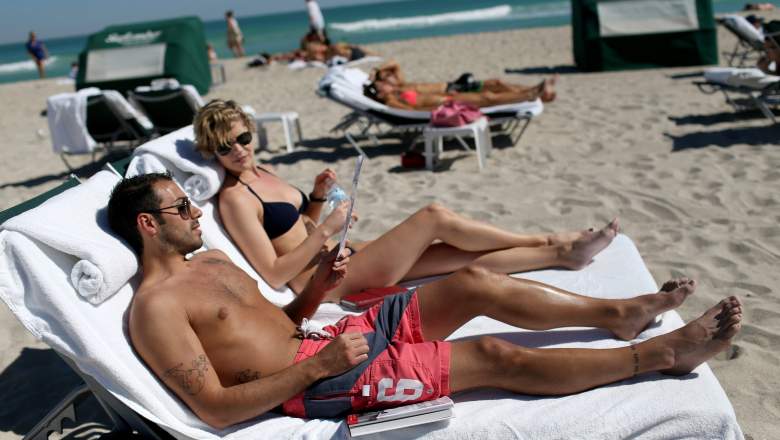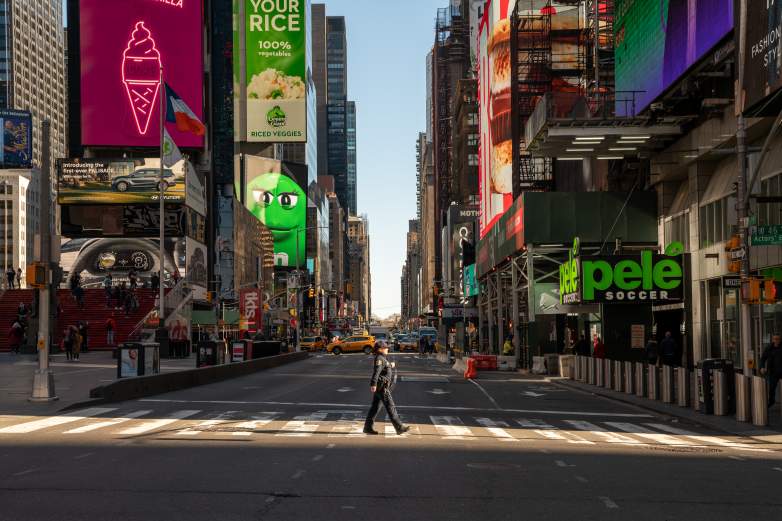
Getty A couple sunbathes on Miami Beach in 2015.
With nearly 3 million confirmed cases of COVID-19 worldwide and almost 200,000 deaths caused by the virus, time is of the essence to learn more about the novel coronavirus so we can save lives and get back to normalcy.
Researchers are working to understand coronavirus and find a way to stop its crippling effect on society and human health as fast as possible, but with so many unknowns and the limits of scientific testing, reliable information is proving difficult to ascertain.
One study released April 7 looked at cases in 320 cities in China to try to understand where people were when they contracted the virus. What they found was that the vast majority were infected in an indoor environment, while only one case of COVID-19 spread was found to have happened in an outdoor setting.
It’s important to note that the study has not yet completed peer-review, so until then it cannot be considered established and accepted medical or scientific cannon. The paper was published as a preprint, which is a way to get the information out there sooner than the months or even years it sometimes takes for a study to be peer-reviewed, according to American Journal Experts. With the urgent need for information that may give insight into how coronavirus behaves, the study has been published early; it is to be considered — but the study is not verified as hard fact.
The Study Concluded That Sharing Indoor Space Is a ‘Major’ COVID-19 Infection Risk

GettyA police officer crosses the street in a nearly empty Times Square on March 12, 2020, in New York.
The authors of the study categorized possible places where the virus could be transferred from person to person. They considered homes, public transportation, food, entertainment, shopping and miscellaneous.
Their findings concluded, “Home outbreaks were the dominant category, followed by transport. … We identified only a single outbreak in an outdoor environment, which involved two cases. Conclusions: All identified outbreaks of three or more cases occurred in an indoor environment, which confirms that sharing indoor space is a major SARS-CoV-2 infection risk.”
The authors of the study wrote that the places we live and work were the most likely to facilitate the virus’ spread, saying, “People are in constant contact as they move from one indoor space or building to another, which creates an indoor contact network through which a virus can spread.”
They do say, however, that their findings do not rule out that the virus can be spread outside. Of the 7,324 cases they looked at, they only found two cases that seem to have contracted COVID-19 outside. In that case, a 27-year-old man had an outdoor conversation with another man who’d recently been to Wuhan, where the virus originated, and those men both tested positive.
The authors of the study note that there were several limitations to their research, writing, “We only studied outbreaks in China, where very strict intervention measures were implemented. We relied fully on the case reports of the local health authorities in each city, and variation exists in the details and the quality of their original epidemiological investigations. We also made no attempt to access any of the infection venues, and the details of each of these indoor spaces remain unknown.”
There Is Still Very Little Conclusive Information on How to Slow the Spread of Coronavirus or How to Treat It
Former Commissioner of the Food and Drug Administration, physician, medical policy expert and public health advocate Scott Gottlieb tweeted about the study, suggesting some social activities could possibly still happen as long as they happened outside.
Still, the findings only suggest that the virus spreads more easily inside, not that it does not spread outside. It seems that decisionmakers are looking for any information to consider as researchers and world leaders grasp at straws to find ways to get the virus’ spread under control.
In navigating this pandemic hope has sometimes turned to disappointment as a drug or treatment that is touted as promising is met with findings that it’s not going to work. For instance, the drug remdesivir was found to show improvements in a majority of patients in one U.S clinical trial earlier this month, but now the World Health Organization is reporting that a clinical trial of that drug in China was a failure, according to the BBC.
A Brazilian study published Friday in the Journal of the American Medical Association found that another drug mentioned by the Trump administration as a possible treatment for COVID-19 patients, chloroquine, proved to be unsafe because the high doses needed to be effective in killing the virus are harmful to humans. The FDA also cautioned against using chloroquine, saying it can cause heart rhythm problems.
President Trump came under fire on April 23 for his comments suggesting that people could possibly be injected with sunlight or disinfectants during a press briefing as a way to kill the virus. Those suggestions illustrate the fact that we are nowhere near finding a legitimate drug to treat COVID-19 patients, but some scientists don’t think a drug is necessarily the only way to help them. Another approach being developed is that of using antibodies to fight the virus, which is a century-old practice that some medical researchers think holds promise.
Other studies are looking at what kind of effect sunshine, heat and humidity have on the virus. Bill Bryan, the head of the science and technology directorate at the Department of Homeland Security in the Trump administration, reported preliminary findings at the April 23 White House briefing on that subject. He said that their study showed that ultraviolet rays plus heat and humidity negatively affects the half-life of the virus, making it weaker. Bryan also said they found that coronavirus is most potent indoors and in dryer air.
However, according to WHO, “From the evidence so far, the COVID-19 virus can be transmitted in ALL AREAS, including areas with hot and humid weather.”
READ NEXT: More Florida Beaches to Reopen Amid Continuing Coronavirus Spread
